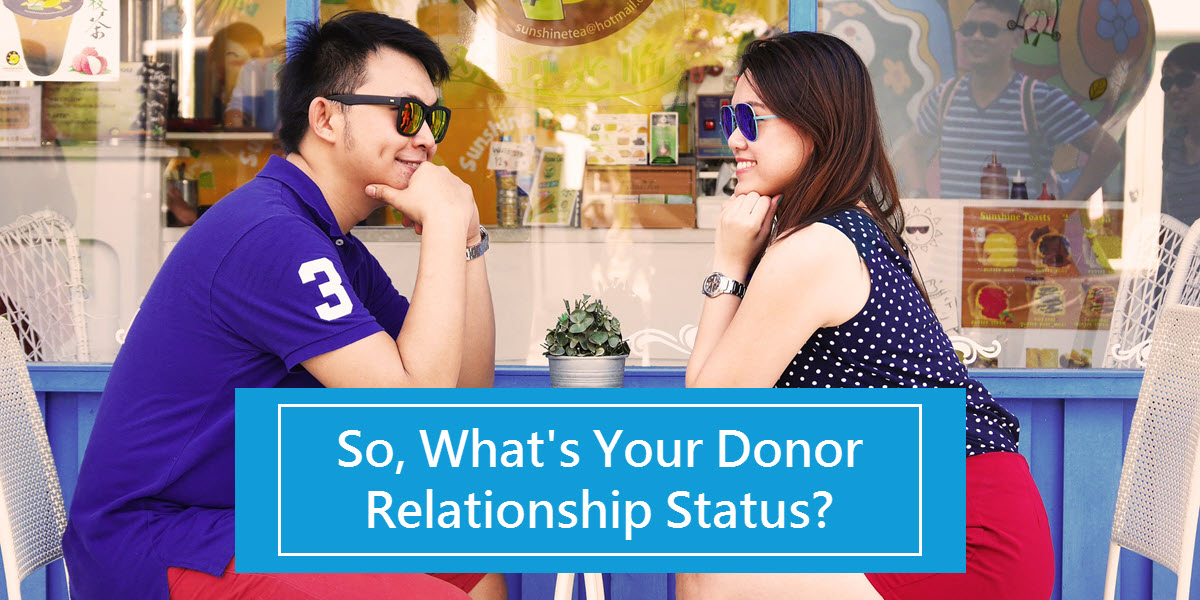
From first glance to 100th date, relationships take dedication, commitment, and hard work. While romances may be more fraught with anxiety, donor relationships require just as much time and effort if you want them to last. Those first-time butterfly feelings can be exciting in a new relationship, but it’s often those bonds we hold on to that lead to the most beneficial outcomes for both parties. So let’s take a look at the relationship stages of donors from courtship to lifelong partners.
Call Me Maybe…
Let’s start from the beginning. Maybe you have a new donor in your sights or you’ve fallen out of touch and want to rekindle your bond. Let’s take a look at how to draw them in.
Majorly Out of My League
Asking for donations, especially from someone you don’t know that well yet, can be a challenge. If you focus on the added pressure of soliciting a major gift you might never get up the nerve. Fortunately, major donors want to be wooed just like anyone else.
First, take a step back. You’re not pursuing a major donor because you want something from them, you’re trying to make a genuine connection because you have a shared interest and you have something to offer them. Putting a different spin on your outreach can boost your confidence, and that’s a great quality to display when starting a new relationship. Most importantly, do your research and get to know them. Show an interest in them by asking questions and letting them do the talking.
The Friend of a Friend
Want a great way to meet new donors? Ask existing donors, board members, staff, and other people in your network to introduce you to their friends. They can even make the ask for you! Software like DonorPerfect offers crowdfunding forms that make it easy for others to fundraise on your behalf.
After your mutual friend has made the initial introduction, you can start cultivating a new relationship. Not sure how to get started? Try a mix of different outreach methods, remembering the old adage, “different strokes for different folks.” Make sure to keep track of your solicitations so you can gauge what appeals to your donor as you get to know them better. Contact manager tools are a vital resource in managing touchpoints with constituents and will help build a solid foundation for new relationships. For other great ideas on where to meet new donors, check out 19 Places Potential Donors Could Be Hiding.
We Only Stay in Touch on Social Media
Lapsed donors are nothing new to nonprofits, but maybe it’s time to rekindle an old friendship. First, take a moment for self-reflection: what caused your constituent to walk away in the first place? A lack of communication, never available, didn’t show appreciation? Let your donor know you’ve changed and you’re not going to make the same mistake twice.
Here are some donor relationship savers:
Communicate Like a Pro
There’s no such thing as too much communication. Research has shown that soliciting donors as often as 21 times a year has no adverse effect on contributions. So get in touch and use a variety of methods to make sure your donor receives the message. Check out tools like Constant Contact and DonorPerfect to make sending and tracking emails a breeze.
Make Yourself Available
Stop playing hard to get. The donation process should be accessible from anywhere and completed in a few simple clicks. Invest some time in creating seamless online forms that are mobile-friendly as well. If you’re out of the office to meet with donors have an easy option for them to donate in person. Mobile apps like DPMobile can make it simple to accept credit card donations from anywhere.
Show Them Love
Make sure your thank-yous are personal and timely. GuideStar reports that donors who receive a thank you within 48 hours of giving a gift are 4 times more likely to give again. Creating an individual thank you letter or email for each person who has donated can seem overwhelming but receipting tools can get your thank you letters out the door in record time.
Keep Your Donors Engaged
When it comes to keeping your donors interested, you already have a head start because your mission is a shared interest and your donor cares about the work you do. So here’s where you can show off a little by letting them know about your accomplishments. Keep your content up to date and highlight your donor’s integral role in your successes.
Let’s Stay Together…
Your new donor has shown some interest and you don’t want to scare them away. Here are some ideas to get them to commit to you.
Is It Too Soon to Call?
So your donor just made a gift to you, it’s too soon to solicit them again, right? This is not the case at all. Your donors are excited to hear from you. The Better Fundraising Co. found, through extensive research, that donors who made a donation in the last month were the most likely to respond to a new solicitation. Keep the lines of communication with your donors open and you’ll find that they respond positively.
If you’re staying in touch by phone, check out 5 Steps to Prepare for a Phone Fundraiser.
Should I Introduce Them to My Friends and Family?
Help your donors feel like part of the team by introducing them to staff, board members, volunteers, and fellow donors. Make it a point to ensure they mingle with your team at events. You can also highlight particular team members in newsletters or publications, and use social media to acknowledge work anniversaries or a volunteer who has reached a milestone in time contributed. Knowing all of the amazing people who make your mission happen can help donors feel even more connected and invested in your cause.
Are We Going Steady?
One of the best ways to cultivate enduring donor relationships is through monthly giving. It’s like having a standing lunch date with your best friend. If you don’t already have a program in place, check out DonorPerfect’s Monthly Giving Starter Kit to learn the basics. The best part is, monthly gifts can be completely automated, eliminating any extra work for you. If you already have a program in place, check out Growing Your Monthly Giving Program for some tips on acquiring new recurring donors.
Share Your Hopes and Dreams
Let your donors know about your goals and plans for the future. Help them to become an essential part of your work by including them in upcoming opportunities. Fidelity Charitable conducted a study finding that 87% of volunteers provide financial support and 79% of donors become volunteers. Research has also shown that volunteers are more likely to make larger contributions and have higher retention rates, so try cross-pollinating your volunteer and donor lists. Your donors want to be a part of the solution in more ways than one and creating a shared vision for the future is a great way to keep their attention. Check out this easy way to recruit and track volunteers.
Have I Told You Lately…
You and your donor have been together for years. Keep the relationship healthy and thriving by continuously letting them know just how wonderful they are.
Show Your Gratitude
Say thank you as often as you can and make sure your donors know they are appreciated. Your thank you letters are so important. Spend some time creating genuine and personalized letter and email templates crafted around what they donated towards. Software like DonorPerfect can even assign a thank you code for you based on criteria pulled from the donor and gift record. If your letters need some freshening up, check out 30 Words or Phrases to Use Other Than “Support” to keep your content exciting.
Keep the Spark Alive
Your donors are passionate about the cause you promote, so keep them passionate about your organization too. Remember this is a two-sided relationship and while they want to hear from you, you should want to hear from them too. Your donors’ opinions matter and listening to their feedback can keep your relationship thriving.
Ask them:
1. What did you think about our last fundraiser event? What did you like, what would you change?
2. What topics would you like to see covered in our newsletters? What do you want to know about our work?
3. Would you be interested in volunteering for x,y,z?
Come up with a list of questions you would like your donors to answer. You could post the questions on social media, send out mailed surveys, or streamline the process by sending out an online survey.
Establishing and maintaining a strong bond takes hard work, but lasting donor relationships are worth it. For more tips on getting your donors to stick around, check out Your Donor Retention Toolkit.
Do you have other tips on how to stay together? Share your best donor retention secrets in the comments section below.





